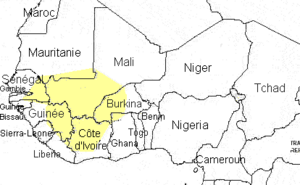Manding languages
| Manding | |
|---|---|
| Geographic distribution | West Africa |
| Linguistic classification | Niger–Congo
|
| Subdivisions |
|
| Language codes | |
| ISO 639-2 / 5 | man |
| Glottolog | mand1435 |
 Extent of Manding languages | |
The Manding languages are mutually intelligible dialects or languages in West Africa of the Mande family. Their best-known members are Bambara, the most widely spoken language in Mali; Mandinka, the main language of Gambia; Maninka or Malinké, a major language of Guinea; and Dyula, a trade language of the northern Ivory Coast and western Burkina Faso.
Subdivisions
The Manding languages, and what distinguishes one from the rest and relationships among all of them are matters that continue to be researched. In addition, the nomenclature - being a mixture of indigenous terms and words applied by English and French speakers since before colonization - makes the picture complex and even confusing.
The Mandinka people speak varieties from the first two groups; the differences between the western and eastern branches manifest themselves primarily phonetically. While dialects of the western group usually have 10 vowels (5 oral and 5 long/nasal), the eastern group, typified by Bambara, has 14 vowels (7 oral and 7 nasal):
- Manding-West
- Kassonke – Western Maninka (Mali, Senegal)
- Mandinka (Senegal, Gambia, Guinea Bissau)
- Kita Maninka (Mali)
- Jahanka (Guinea, Senegal, Gambia, Mali; one of several dialects under this name)
- Manding-East
- Marka (Dafin) (Burkina Faso, Mali)
- Bambara–Dyula (Northeastern Manding; Mali, Burkina Faso, Ivory Coast)
- Eastern Maninka (Southeastern Manding; multiple varieties in Mali, Guinea, Ivory Coast)
- Bolon (Burkina Faso)
In addition, Sininkere (Burkina Faso) is of unclear placement within Manding.
Writing
The Manding languages have a strong oral tradition, but also have written forms - adaptations of Arabic and Latin alphabets, and at least two indigenous scripts.
- Arabic was introduced into the region with Islam, and the writing was adapted to write in the Manding languages. Arabic script or Ajami is still commonly used for Mandinka.
- The Latin alphabet was introduced into the region following European conquest and colonization. It is used fairly widely, with "official" versions in many countries, for teaching, literacy and publication.
- The N'Ko alphabet, developed in 1949 by Solomana Kante, is designed to write Manding using a common literary standard comprehensible to speakers of all these varieties. It is gaining in popularity.
- A lesser-known alphabet for Bambara was developed in the early 20th century but is not used.
